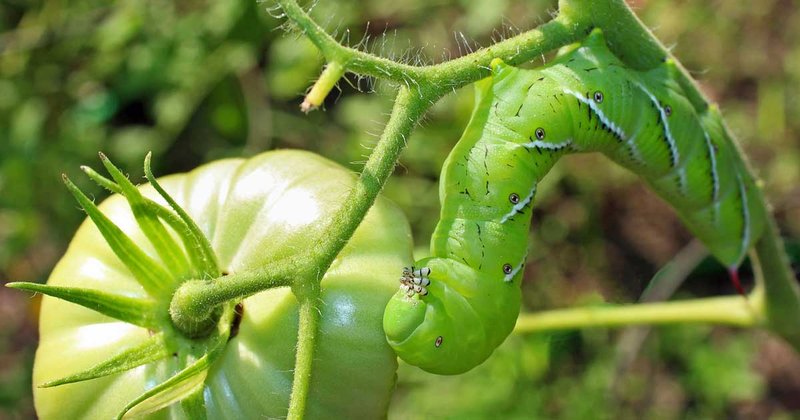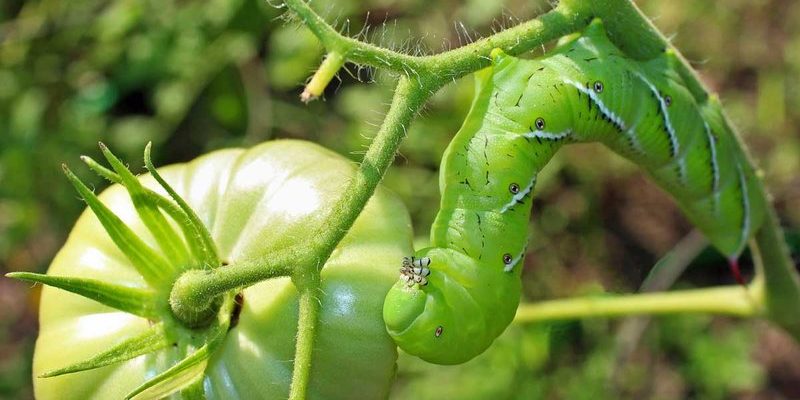
Tomato hornworms are large, green caterpillars that can grow up to 4 inches long. At a glance, they might look like they’re just part of your plants, but trust me, they’re trouble. These guys are the larval stage of the five-spotted hawk moth. While they may sound intimidating, spotting and managing them isn’t as hard as it seems. With a little bit of knowledge and vigilance, you can keep your garden healthy and thriving.
What Are Tomato Hornworms?
Let’s break down what tomato hornworms really are. These caterpillars are the larvae of the **five-spotted hawk moth**. You might not see the moth itself often, but its offspring can wreak havoc on your vegetable plants. Tomato hornworms are typically a vibrant green, which helps them blend in seamlessly with the leaves of your tomato plants. This camouflage is one reason why they can go unnoticed until it’s almost too late!
Here’s a fun fact: while they primarily feed on tomatoes, they don’t discriminate. They might also target peppers and eggplants, so if you’ve got a diverse vegetable garden, keep a close eye on all your plants. Think of them as opportunists, so always stay vigilant. You might be wondering how to tell if a hornworm has been munching away on your plants.
Physical Characteristics
Tomato hornworms have distinct characteristics that make them relatively easy to identify despite their sneaky nature. First, their body is long and slender, reaching lengths of up to 4 inches. They’re typically a deep green color, which helps them blend in with the foliage. Look for the **diagonal stripes** that run along their sides and the small horn-like appendage on their rear—this is where they get their name.
Another interesting detail? If you look closely, you might spot some tiny, white, parasitic larvae on the hornworm. These larvae are actually a sign of beneficial insects and can help control the hornworm population. Think of it as nature’s little army fighting on your behalf!
Signs of Tomato Hornworm Infestation
So, how do you know if tomato hornworms have invaded your garden? Here are some telltale signs to look out for:
- Chewed Leaves: One of the first signs you’ll see is the suddenly *ragged* leaves on your tomato plants. Hornworms have a voracious appetite and will eat entire leaves, leaving behind large holes.
- Droppings: You may also notice small, dark green or black droppings near the affected plants. These are a clear indicator that hornworms are nearby.
- Presence of the Worms: Of course, the most obvious sign is spotting the hornworms themselves. Observing them during your regular garden checks can be crucial.
Paying attention to your plants can help you catch an infestation early. Regular checks are key! If you see any of these signs, you’ve got a problem that needs addressing.
How to Identify Tomato Hornworms in Your Garden
Now that you know what to look for, let’s talk about how to find these little gremlins before they do too much damage. Start by examining the undersides of the leaves, as hornworms often hide there to avoid detection.
You might also want to look at the stems. If any leaves are falling off, that’s usually a sign of trouble. Use your hands to gently inspect the plants, and don’t be afraid to get up close. Sometimes you’ll find them just chilling, perfectly camouflaged!
Using Handheld Tools
If you’re not too keen on getting too close, you can use a small flashlight or even a handheld magnifying glass to help spot them. The light can help reveal their color against the dark green leaves. Plus, the magnifying glass can make it easier to check for any tiny eggs or larvae that might be lurking around. Think of it as your gardener’s detective kit!
Effective Control Methods for Tomato Hornworms
Once you’ve spotted those pesky hornworms, it’s time to take action. Luckily, you have several options for controlling them that don’t require you to resort to harsh chemicals. Here are a few effective methods:
- Handpicking: The simplest method is sometimes the best. Just wear gloves and pluck them off your plants. It might sound gross, but it’s very effective! Just make sure you check regularly.
- Beneficial Insects: Encourage beneficial insects, like parasitic wasps, to your garden. They’ll help keep the hornworm population in check.
- Natural Sprays: You can also use natural insecticidal soaps or sprays made from ingredients like neem oil. These are much gentler on the environment while still tackling hornworms effectively.
Implementing these methods can help keep your garden safe without causing more harm than good.
Preventing Tomato Hornworm Infestations
Prevention is often the best defense when it comes to dealing with tomato hornworms. Here are a few strategies you might consider incorporating into your gardening routine:
- Crop Rotation: Change where you plant your tomatoes each year. This makes it harder for hornworms to find their favorite snacks.
- Healthy Soil: Maintain healthy soil with plenty of nutrients. Strong plants are less susceptible to pests.
- Companion Planting: Consider planting herbs like basil or marigolds nearby. They can repel hornworms and attract beneficial insects.
These preventive measures can save you time and resources in the long run. Remember, a healthy garden is a happy one!
Identifying tomato hornworms in your vegetable garden doesn’t have to be a daunting task. With a little knowledge and regular monitoring, you can catch these pests early and take action before they cause major damage. Think of managing your garden as a balancing act—keeping an eye out for hornworms while nurturing your plants. Remember to employ both prevention and control methods for an effective approach.
With your newfound skills, you can protect your tomatoes and enjoy a bountiful harvest. Happy gardening!

